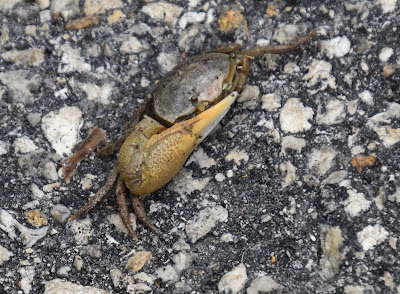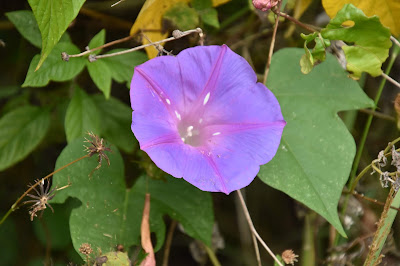The Florida Keys is a chain of islands running West from the tip of the Florida Peninsula. The largest urban area is Key West at the end of the chain. Several people had advised us to avoid Key West, so we didn't go any further than Big Pine Key.
It's not a long drive from the Everglades to the Keys, and it wasn't difficult to find an information office to advise on our options.
John Pennekamp Coral Reef State Park
Florida is outside the true tropics, but we have to admit that the Keys have a tropical feel to them. Except that much of the tropical world is underdeveloped and quite cheap for Westerners, whereas the Florida Keys are distinctly pricey.
We didn't go and inspect the coral reef ourselves, but we accept that there is coral out there.
A White Ibis with pink legs. This means that it is not the breeding season, when the legs become red.
A large lizard.
We had a slight difference of opinion here. Eve thought the water was cold and Bill proved it wasn't by going for a paddle. It certainly wasn't icy, but he admits that it wasn't quite up to the temperature of a relaxing bath. Do you like the T-shirt? It's a souvenir of the Everglades. Can you identify all the birds illustrated?
What's the use of having an underwater camera if you don't take any underwater photographs? If you know what this underwater organism is, please leave a comment to let us know.
Coconut Palms.
The park includes a good little aquarium.
A species of lobster.
A less shy resident of the tank.
We wanted to stay at one of the state park campgrounds, but they are booked up many months in advance. Well, they are much cheaper than the privately operated campgrounds. We weren't very far from the Everglades so we turned around and went back to Long Pine Key Campground.
We decided to have an evening amble around the lake. We came upon a guy with a camera and a tripod and fell into conversation. He wasn't a professional, but he certainly knew photography and was there specifically to photograph the sunset.
We didn't compare results with the expert, but we're happy with our souvenir of the evening.
Laura Quinn Wild Bird Sanctuary
The best value destination in the Keys. Admission is by donation. We were happy to drop a few dollars in the box, because the sanctuary is doing work we approve of, and displayed a good range of birds that are either recovering from some mishap before being released, or have no realistic chance of being able to survive again in the wild. Bill's attempts to photograph through wire cage fronts were not as successful as at Billie Swamp Safari, but some came out well enough.
A Brown Pelican.
A Broad-winged Hawk.
A Great Egret showing signs of developing breeding plumage.
Big Pine Key
A tourist information office had pointed us at a piece of woodland on Big Pine Key with some short trails where there was a good chance of seeing the endangered Key Deer. This is a very small deer that exists nowhere but the Florida Keys.
To get there we had to drive across several keys and their connecting bridges, including the Seven Mile Bridge. Luckily for acrophobe Bill, the bridge isn't very high and there are nice, opaque concrete walls to contain the view, so his heights phobia wasn't much troubled. The Confederation Bridge between New Brunswick and Prince Edward Island was much scarier.
This was too far to double back to Long Pine Key Campground so we stumped up for a private campground. $70 for an unpowered site is very expensive elsewhere, but it's standard in the Keys.
Driving through the camp we saw – a Key Deer. It was between two RVs and had something of the attitude of waiting for a handout. It was tiny, with horns that made us think of a miniature reindeer. Of course it had gone by the time we found our site and went back with a camera.
There were some Willets feeding in a marshy pond by the campground.
The next day we visited the local tourist information office. The lady was most surprised at what we had been told about seeing deer in that particular wood. “I've walked those trails a hundred times and I've never seen a deer there.” Oh well. At least we had seen one.
Theater of the Sea
The Florida Keys has its Marineland in Islamorada. There are restrictions on what they may keep and display, and it's not all performing seals.
Performing sea-lion, to be strictly accurate.
Two of the dolphins performed in the “lagoon”.
They have a collection of parrots that do tricks. This is a Hyacinth Macaw.
Injured marine animals are doctored at Theater of the Sea. If they cannot fend for themselves in the wild then they may stay. This turtle needs extra flotation or it would sink and drown.
The star turn was the dolphins in the pool. They go through an extensive routine, including stunts with one of the trainers in the water.
A high jump.
Here the dolphin and trainer have both surfaced 'feet first' in perfect synchronisation.
Flowers
December is winter in the Northern Hemisphere. Some plants just don't seem to realise this:
To allow our wallet to recover a little we left the Keys and parked overnight at the Cracker Barrel in Homestead, for which there is no charge.





























































